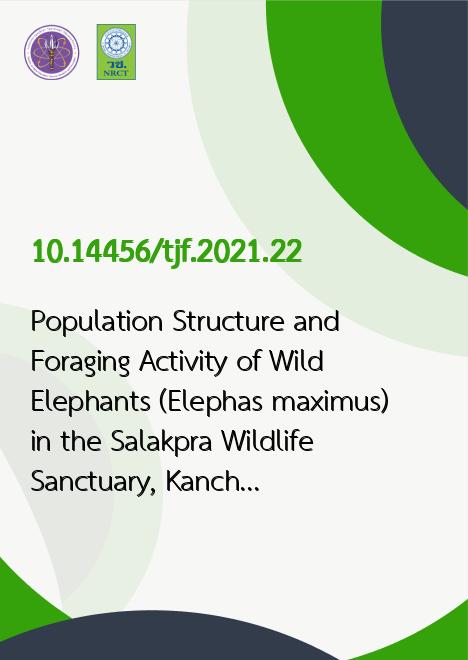
|
Population Structure and Foraging Activity of Wild Elephants (Elephas maximus) in the Salakpra Wildlife Sanctuary, Kanchanaburi Province |
|---|---|
| รหัสดีโอไอ | |
| Creator | Prawit Ainnoi |
| Title | Population Structure and Foraging Activity of Wild Elephants (Elephas maximus) in the Salakpra Wildlife Sanctuary, Kanchanaburi Province |
| Contributor | Yongyut Trisurat, Ronglap Sukmasuang |
| Publisher | Kasetsart University |
| Publication Year | 2564 |
| Journal Title | Thai Journal of Forestry |
| Journal Vol. | 40 |
| Journal No. | 2 |
| Page no. | 128-141 |
| Keyword | Population structure, Activity, Wild elephants, Salakpra Wildlife Sanctuary |
| URL Website | https://li01.tci-thaijo.org/index.php/tjf/article/view/251188 |
| Website title | Thai Journal of Forestry |
| ISSN | 2730-2180 |
| Abstract | The objectives of this study were to investigate the population structure and activities of Asian elephants (Elephas maximus) at the Salakpra Wildlife Sanctuary, Kanchanaburi province, Thailand and to recommend guidance and planning strategies to better manage the wild elephant population. Camera traps were used to capture and classify the elephants by gender and age groups. Data were collected over a six-month period, from March to September 2020. Elephants were categorized into five groups: adult males, adult females, sub-adults, juvenile, and calves. The detection ratios for the five groups as mention above were 1:5.7:0.8:3:1.3 respectively, with an overall sex ratio of 1:5.7 and a reproductive ratio between adult females, adolescents, and juveniles of 1:0.5:0.2, respectively. The Relative Abundance Index (RAI) was calculated at 11.6% and the Relative Frequency (RF) was 100%. The observed activity during the daytime was significantly greater than the nighttime (Chi-squared = 57.019, df = 17, p < 0.001). The two periods of highest recorded activity was 8:00 a.m. to 10:00 a.m. and 3:00 p.m. to 5:00 p.m. This research found that the population structure of wild elephants in Thung Salakpra has changed. The proportion of adult females, subadults, juveniles, and calves has increased compared to past studies. Therefore, if the structure of wild elephant population is surveyed every 5-10 years, it can be possible to better monitor the changes in population structure of wild elephants in the Salakpra Wildlife Sanctuary. |